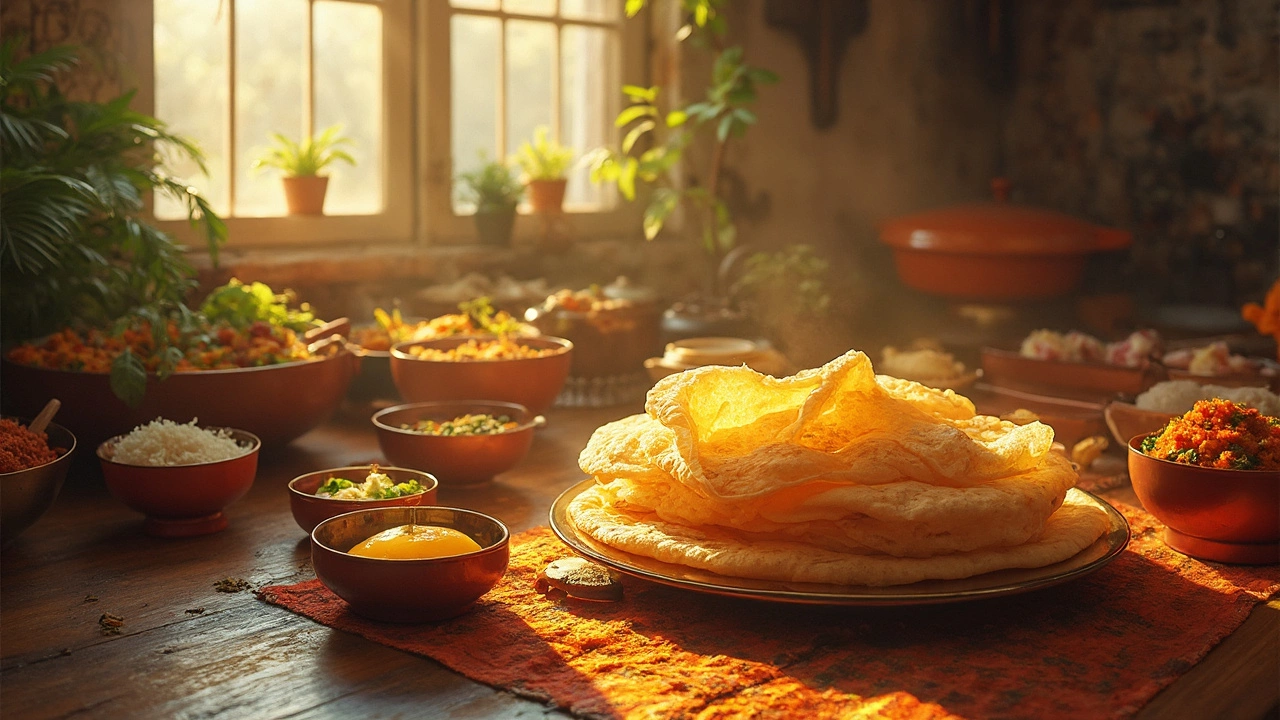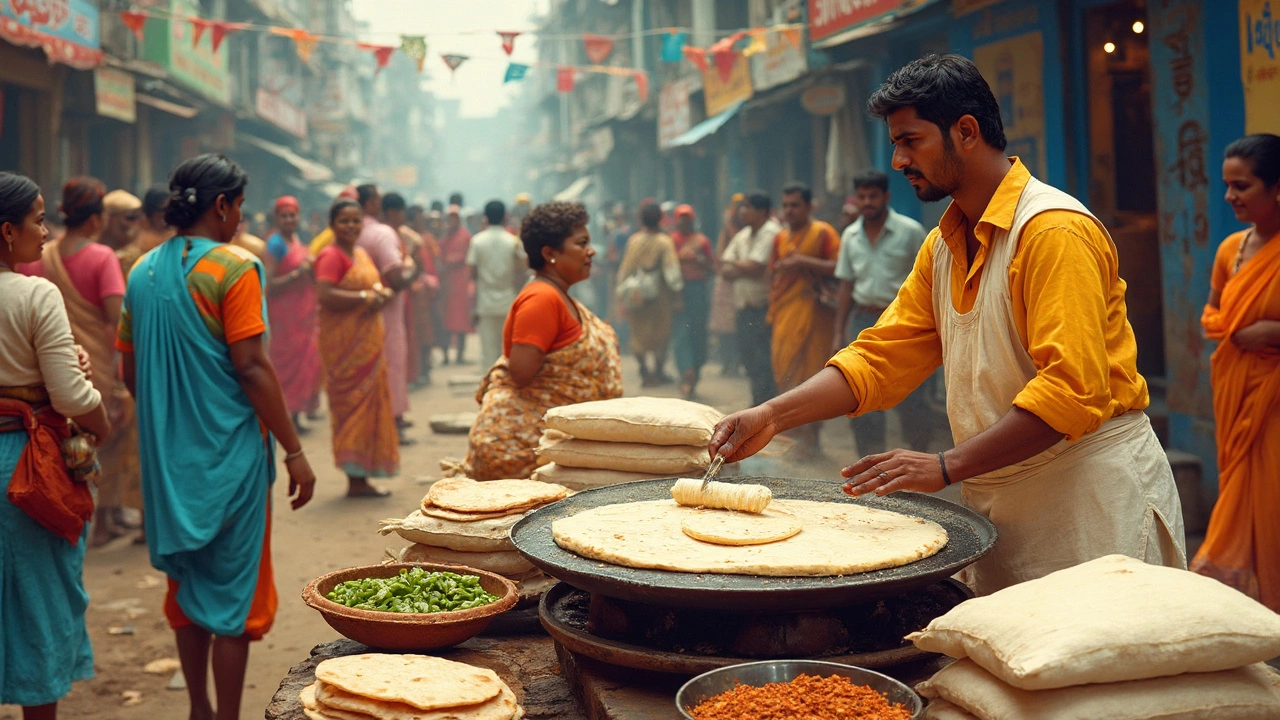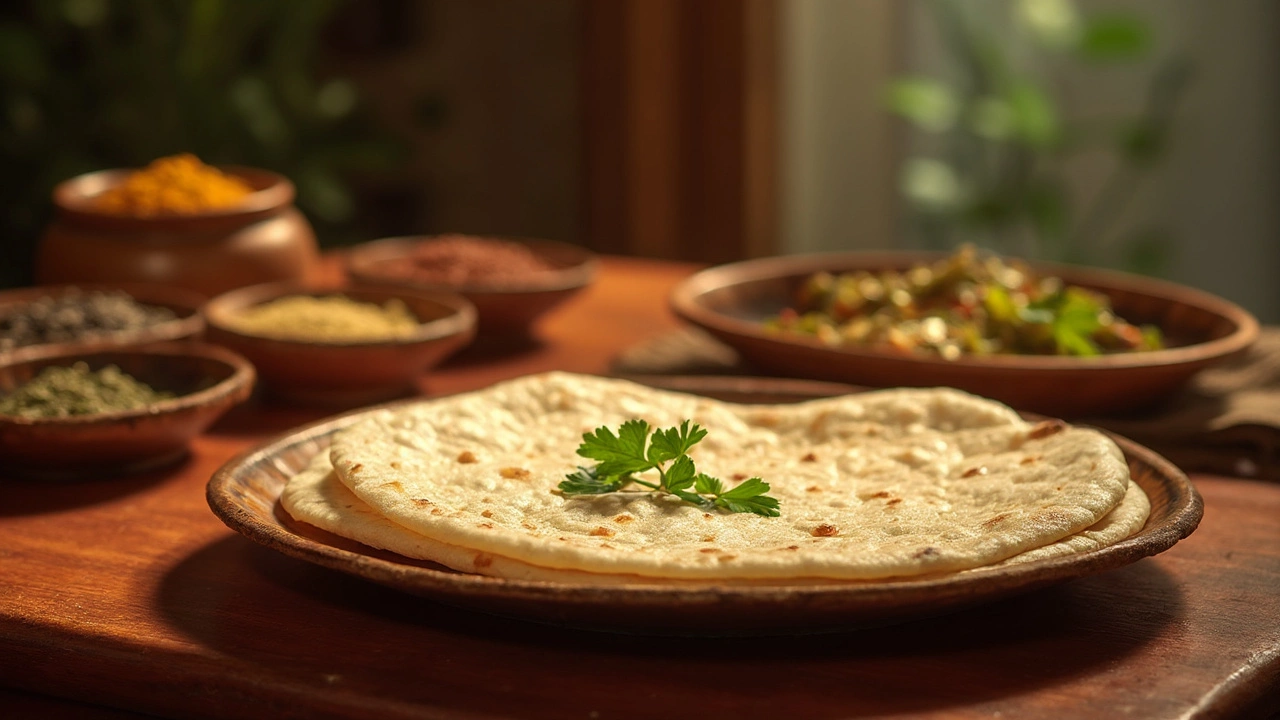The Caloric Facts: Why Roti Remains an Indian Favorite
 Feb, 19 2025
Feb, 19 2025
When it comes to Indian cuisine, roti isn't just food; it's tradition, comfort, and for many, a daily essential. But if you’ve ever found yourself wondering how much calories in 1 roti, you're not alone. A typical homemade roti packs about 70-100 calories depending on its size and ingredients. And yes, when you add that dollop of ghee or team it with a bowl of sabzi, those numbers go up.
Adding ghee, for example, can increase the calories in 1 roti to about 110-130, which makes it richer in taste and energy. Worried about calories in 1 roti and sabzi? Don’t panic. A balanced solution is right around the corner. Small tweaks and mindful eating can help in managing caloric intake without missing out on this staple delight.
Why do we gravitate towards roti despite its caloric content? It's simple—roti offers nutritional value, satiety, and a delightful eating experience. The trick lies in understanding its role in your diet and making smart choices. Let's explore how you can enjoy your roti without the guilt!
- Understanding the Caloric Content of Roti
- Roti with Ghee: A Delicious Twist
- Pairing Roti with Sabzi: A Nutritional Balance
- Why Roti is Indispensable in Indian Dining
- Balancing Calories and Enjoyment
Understanding the Caloric Content of Roti
Roti is a staple in many Indian meals, but ever caught yourself wondering why it remains so popular despite its caloric count? Let’s dig into it. The calories in 1 roti are approximately 70-100, depending on its size and the type of flour used, such as whole wheat. Not too bad for something that’s packed with fiber and energy, right?
Breaking Down Roti's Caloric Content
Let's look at what makes up those calories. The primary ingredients of traditional roti are whole wheat flour and water, with the option of adding a pinch of salt or a touch of oil. Whole wheat flour is rich in complex carbohydrates, which, unlike simple carbs, break down slowly in your body, providing sustained energy.
- Calories in 1 roti with ghee: Ghee ups the ante by providing extra deliciousness and around 40 additional calories.
- Homemade vs. Store-bought: While homemade rotis are simpler, store-bought ones sometimes include added preservatives and ingredients, impacting the calorie count.
How to Make the Most of Your Roti
Here are some simple hacks for savoring your roti without overdoing it:
- Stick to whole wheat flour for that extra fiber boost.
- If you love calories in 1 roti with ghee, consider moderating the amount of ghee or trying alternatives like olive oil.
- Pair your roti with nutrient-dense side dishes to make the most of your meal without overloading on calories.
Sometimes we see a problem—like counting every calorie—and stress out unnecessarily. The solution? Balance. Understanding how many calories in 1 roti helps in planning your meals smarter. Remember, you don’t need to cut out what you love; just enjoy wisely!
Roti with Ghee: A Delicious Twist
Adding a spoonful of ghee to your roti can dramatically change its taste and texture. While you might worry about the calories in 1 roti with ghee, let's not dismiss its benefits just yet. Ghee, also known as clarified butter, adds a rich flavor and contributes healthy fats that aid digestion and provide sustained energy.
So, how much calories in 1 roti with a smearing of ghee? Expect it to bump the count up to around 110-130 calories. Sure, it’s an increase, but these additional calories come with potential advantages like improved digestion and absorption of vitamins. Here’s how to enjoy this delicious twist responsibly:
How to Enjoy Roti with Ghee
- Limit the Quantity: Use just a teaspoon of ghee per roti. It’s enough to enjoy the taste without a massive calorie overload.
- Go for Quality: Choose pure and organic ghee for best results. Its purity ensures you're getting the nutritional benefits without the additives.
- Pair Smartly: Complement your roti with ghee with light sabji or dal to balance the meal. This combo enhances flavor and nutrition.
Worried about consumption? Try alternating days with plain roti. This simple habit lets you enjoy both versions while keeping an eye on your diet. Remember, the key is moderation.

Pairing Roti with Sabzi: A Nutritional Balance
Teaming up **roti** with a variety of **sabzi** is like creating a power-packed meal that satiates and nourishes. This combination doesn’t just make the meal complete but also boosts its nutritional punch, offering a good mix of carbohydrates, proteins, vitamins, and minerals.
The Ideal Plate
Wondering how **calories in 1 roti and sabzi** could work in your favor? It’s all about balance. With roughly 70 calories in a regular roti, adding a nutritious sabzi can keep the entire meal under 300 calories, depending on portion sizes and the type of vegetables used.
For a perfect nutritional blend, aim for half a plate of vegetables, a quarter of it with a roti, and the other quarter with protein like lentils or paneer. This way, you're getting your fiber, vitamins, and essential nutrients without going overboard on calories.
Step-By-Step Meal Prep
- Choose Your Roti: Opt for whole wheat roti for more fiber and nutrients.
- Get Colorful Sabzi: Pick a variety of veggies like spinach, carrots, and peas, cooked with minimal oil for a low-calorie boost.
- Add Protein: Add dals or paneer to uplift the protein content further, enhancing satiety.
- Portion Wisely: Stick to one or two rotis paired with a generous serving of sabzi.
Implementing these tips ensures that you're creating a meal that’s delicious yet aligned with your dietary goals. Plus, it’s perfectly adaptable! Whether you’re having spicy aloo gobi or a mild zucchini stir-fry, this combo keeps your meals exciting yet grounded in tradition.
The Caloric Table
| Component | Calories |
|---|---|
| 1 Roti (Medium) | 70-100 |
| Sabzi (1 bowl) | 150-200 |
| Total | 220-300 |
These figures remind us that balancing flavors with mindful choices makes for a fulfilling experience, reinforcing why roti continues to be a cherished meal essential.
Why Roti is Indispensable in Indian Dining
Imagine an Indian meal without roti. Impossible, right? Let's dive into why this humble flatbread is so important. Roti, a simple mix of whole wheat flour and water, isn't just food—it's part of the culture. With its roots deep in history, roti has been filling hungry bellies for generations. And there's more to it than meets the eye.
Roti is a nutritional powerhouse. Packed with fiber, it's a great source of energy that keeps you going. It’s the way people have been fueling their day long before the invention of fast food. This high fiber content aids digestion, keeps you fuller longer, and helps maintain cholesterol levels—all crucial components of a healthy lifestyle.
The Daily Ritual
For most Indians, making roti is a daily ritual. But why? It's all about tradition and the taste of home. Preparing fresh roti with a simple rolling pin and a hot griddle is a comforting routine in many households. You could say it's the ultimate example of 'homemade' goodness.
Versatility at Its Best
Have you ever considered the versatility of roti? Whether with traditional curry or as a wrap, it works like magic. Its modest flavor and texture act as the perfect backdrop for an array of dishes. From spicy sabzi to flavorful dals, it complements every bite.
Balancing the Caloric Concerns
Alright, here's the twist. With all this talk about calories in 1 roti, maintaining a balance is important. So how do you enjoy roti without the calorie creep? It's simple. Opt for a thin roll, load up on nutritious sabzi, and moderate that tempting ghee spread. A win-win for your tastebuds and health!
| Health Benefits of Roti | Description |
|---|---|
| High Fiber | Supports digestion and fullness |
| Low Glycemic Index | Steady energy without blood sugar spikes |
| Versatile | Pairs well with a variety of dishes |
This age-old staple is more than just a part of a meal; it’s a piece of cultural heritage. So next time you reach for a piece of roti, remember you're part of something much bigger.

Balancing Calories and Enjoyment
Enjoying roti doesn’t mean you have to go overboard on calories. When you’re conscious of the caloric content, you can savor your meals without any guilt. So, how exactly do you balance taste and nutrition? Let's break it down!
Step 1: Portion Control
First things first, moderation is your friend. Keep an eye on how many calories in 1 roti you’re consuming. If you can reduce the size or number, you can easily manage your daily calorie intake. Maybe start with one roti with ghee instead of two and load up on veggies for satiety.
Step 2: Healthier Ingredients
Next, consider what goes into your roti. Opt for whole wheat flour, which is high in fiber and will keep you fuller for longer. Swap ghee for olive oil or even skip the fats to save on consumption.
Step 3: Mindful Pairing
Team your roti with low-calorie pakoras and sabzis. A vegetable curry can add flavor without adding many calories to the calories in 1 roti and sabzi. Check your portions and reduce any calorie-heavy sauces if necessary.
Step 4: Active Lifestyle
Incorporating exercise into your routine helps burn off those extra calories. Whether it’s a brisk walk or yoga session, staying active balances your diet perfectly.
A Quick Caloric Comparison
| Food Item | Calories |
|---|---|
| Plain Roti | 70-100 |
| Roti with Ghee | 110-130 |
| Roti with Sabzi | 100-150 |
Balancing indulgence with health is easier than it seems. Making little shifts can help you enjoy your food without the worry. Dive into a meal plan that celebrates taste and health to truly enrich your dining experience.